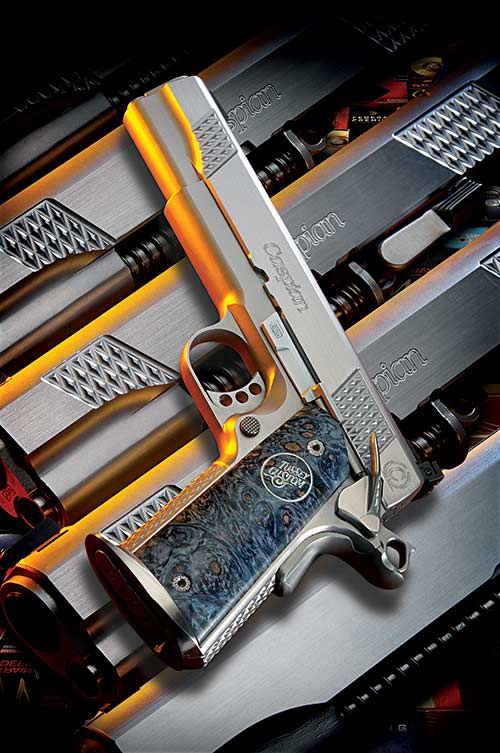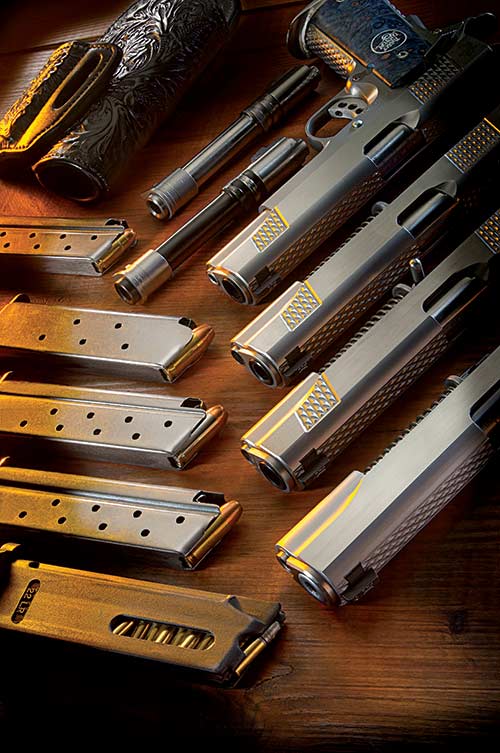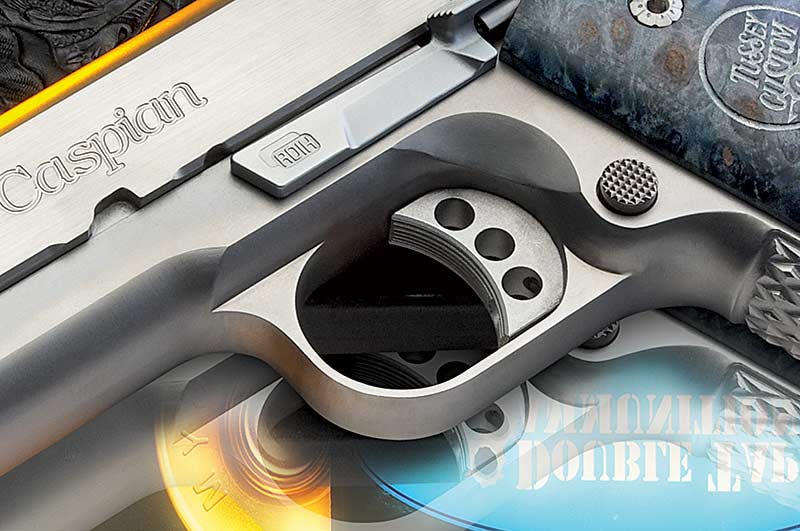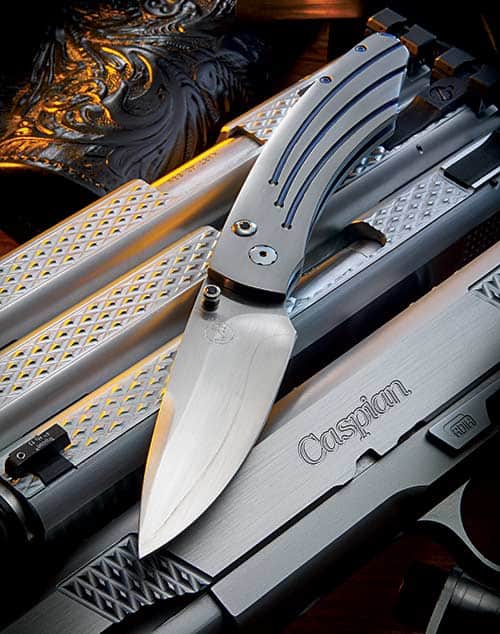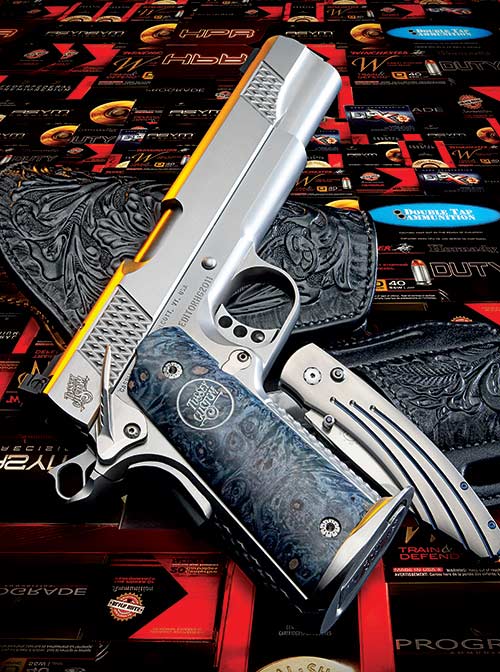Six Calibers In One: Tussey's Multi-Caliber Marvel!
One Frame = .22 LR, 9mm, .38 Super, .357 SIG, .40 S&W and .45 ACP!
I’ve been thinking …” It was Terry Tussey on the phone a couple of years ago. “I’ve built multi-caliber gun sets before, usually .45 and .38 Super, or .45 and .22 on one 1911 frame.”
“Uh-huh,” I said, “I’ve seen one or two of those and always thought it was a swell idea.” I wondered what this was really all about.
“But …” he said, followed by a long pause — Terry does long pauses — “how about a 6-caliber conversion set? Does that get your attention?” I could hear him smiling on the phone.
“As in six calibers on one 1911 frame?” I asked, getting interested now, but trying not to act like it.
“What else would I mean? You may be the editor, but at times I wonder how that happened,” sighed Terry. “Yeah, I’m thinking .22, 9mm, .38 Super, .40, .357 SIG and .45 ACP. Maybe even 10mm if I’m in the mood. That wouldn’t be anything you might be interested in seeing, would it?”
“Oh, gosh,” I said, my voice cracked just a tiny bit, but Terry caught it I’m sure, “I haven’t seen a set like that all week. Might be something I could squeeze in. But that’s only if you can actually do it, that is. I mean, I’ve never heard of that before.” The sigh again on the phone. “I’ll get back to you.” Click.
Back To Me
“Okay,” it was Terry on the phone about a year later. “It’s done.”
“What’s done?” I asked.
“It,” then the sigh again.
“Oh, it …” I said.
“But no 10mm. I was going to toss that one in too, and I could do it if someone really needed one,” he explained, “but I got tired of fitting barrels and slides, you know?” he said. “I mean, isn’t six enough for you, for crying out loud?”
“It’s enough,” I said. “Can I borrow it all long enough for photos and an article? Nobody will believe me if I tell them about it unless there’s photos, and I’ll wager even those jaded Handgunner readers might actually raise an eyebrow with this set.”
“Sure.” Click.
Tussey Custom
Terry is not only an old friend, but someone I recommend to people all the time if they need some pistolsmithing done. Terry does a lot of “general” pistol work too, things like fixing your broken gun, along with, as he calls it, “fancy work.”
Terry’s fancy work has graced our pages in the past, and if you still have it, check out the March/April 2009 issue to see two remarkable Hi-Powers he did. Terry tends to do a great job on the basics, like making guns run right, suddenly become more accurate and even get a bit fancier too. But between us, what he really likes to do is kind of “go places no man has gone before” sorts of stuff.
For the Hi-Power article he created a long-slide (using two standard slides) and a short, lightweight (aluminum frame) Hi-Power. The set is a stunner and raised the bar on Hi-Power customization in one fell stroke. Terry is also one of the rare, small (very small) handful of custom pistolsmiths who can make tiny 1911’s run right. I have one of the very first aluminum Colt Officer’s ACP guns which Terry fancied up some. I carried that gun for almost two decades as a cop, as a back-up and off-duty gun and it has, honestly, never failed. Never.
Terry has been doing 1911 work since his days working for Colt selling guns. That’s um … er … “50-some” years as he says. Terry knows the 1911 from every conceivable angle. If it’s been done with/to/for/by a 1911, odds are Terry either did it first, figured it out or made it better. He’s rubbed shoulders with every “who’s-who” in the game, and there is likely not a living ’smith today who doesn’t know Terry or know of him.
Can you say “icon?”
I’m honored to call him a friend, and even more surprised and delighted when he builds things like this multi-caliber wonder-gun and allows me to share them with you.
The Concept
In Europe, where it’s tough to own guns, many companies offer guns with easily switchable barrel/caliber options. Once you get one receiver or frame, you can then easily change to other calibers or formats (long barrels, short barrels, different stocks, etc.) without having to do the paperwork horror routine. It works for Europeans.
But here in America, that technology usually falls flat. Here, we’d rather simply get another gun in a new caliber or design. Not only is it easier to actually buy another gun here, but we Americans simply like any excuse to buy a new gun. A wood-working friend of mine said, “Never plan a project unless it requires you to buy new tools to build it.” I think we shooters tend to apply the same theory to gun owning.
But in Terry’s case, he made an excellent point about why this sort of multi-caliber kit actually makes perfect sense.
“Normally,” he explained, “you might own, say, a 1911 in .45 ACP, maybe one in 9mm and one in .38 Super too. That’s great and there’s nothing wrong with that. However, each gun is different, even if they are the same model from the same maker.
“The .45 will likely have a certain trigger feel, the 9mm will likely be slightly different and so will the .38 Super, with take-up, break, weight, etc. all different,” he continued. “If you’re a serious target shooter or competitor who uses multiple calibers in your chosen sport, you need to acclimate to those differences in your guns.”
Terry’s spot-on with this. I once did a test using five 1911’s from the same maker. Identical models in every way, yet each was slightly different. Each had different trigger weights, different feels to the trigger take-up and break, each safety “snicked” differently, even each grip had its own imperfections you could feel. None of this is noticed if you just shoot one gun, but going from one to the other made it clear they were all the same — but all different.
A Better Idea
“What we have here with this multi-caliber set,” Terry went on, “is the ability to condition yourself to one action, one trigger, one safety and one grip. When you pick this gun up, regardless of which slide/barrel you have installed, it will ‘feel’ exactly the same. The trigger break will be exactly what you’re used to whether you’re shooting the .22 or the .45.”
I had not thought of that before Terry said it, and it makes absolutely perfect sense. If you have a target .22 you shoot, you get used to it. Now transition to a 1911 in .45 ACP for your local match, and you need to get used to that gun all over again. Bounce to your target-sighted 9mm for PPC shooting and you start at the beginning again. Different safety feel, different grip safety, different grip feel and a “different” trigger.
This gun set has made me rethink the concept of multiple-caliber sets. I’ve always enjoyed having a Colt ACE .22 unit, and it usually rides on a target 1911 I have. And indeed, it’s nice to slip the ACE slide assembly on and still have the very familiar target gun in my hand. Damn if he isn’t right again.
The Big Secret
I spent some time on the phone going over the details on this compelling example of the multi-caliber notion. Apparently, in spite of Terry’s casual “Oh, it’s not a big deal” attitude, there were a few, um … “challenges” as he called them. It was a big deal.
Starting with a Caspian frame and slides (except the Colt ACE unit), Terry went to work. He stressed he likes to use Caspian because it’s essentially one-stop shopping.
“From the frames and slides, to the safeties, firing pin stops, firing pins, ejectors and the rest, Gary Smith and the gang at Caspian take good care of their customers,” said Terry. “In this case, I asked Gary to make sure all the sight cuts were the same and the slides the same. It makes final fitting much easier. I used Kensight adjustable rears and Novak fronts, and since all the cuts were the same, I knew just what needed doing to fit each one. And that’s another good thing about this sort of a set, you end up with the exact same sight picture on each one.”
There’s a big secret on how to fit slides in different calibers to all work on the same frame on a 1911. According to Terry, only the 5″ .45 ACP 1911 uses a “certain” design in ejector, and the slide is cut to fit it. All of the other calibers use a different style of ejector. So I asked Terry how he made it work.
“That’s the secret,” he said, laughing. “If a good pistolsmith thinks about it hard, they will likely figure it out. But I’m going to make ’em work for it in this case,” he said through the grin on the other end of the phone.
So in this case, suffice to say, Terry carefully fits all the slides to a single frame, then fits all the barrels into those slides and to that frame — and then a miracle occurs — and it all works.
“I will say I used ramped barrels for each caliber, and had the frame cut to fit them. Then, I fit the first barrel — the .45 — making sure everything ran right, the set-up was accurate and it fit the frame perfectly. Then I basically chased that set-up with the remaining slides and barrels. A couple of the calibers needed several barrels before I found one I could fit correctly. I used Clark, Barsto, Ed Brown and KKM barrels and the stock Colt barrel lives in the .22 ACE unit,” explained Terry.
Other Issues
In the box with the gun and slide assemblies, I found several sets of recoil springs. I called Terry about them.
“A shooter is asking a lot with this concept,” he said. “The mechanics of making sure all this stuff fits together and actually works is hard enough, but I was determined to make sure each caliber delivered match-grade accuracy and 100 percent reliability,” Terry continued. “I used full-length recoil spring guide rods for this set-up. Not because I think they contribute a damn thing to reliability or accuracy — which I don’t think they do — but because they capture the recoil springs.
“If you push out the slide release and slip the slide off the frame, the recoil spring set remains in place. That way you don’t mess things up. I sent extra springs so you could experiment if you needed to, depending upon the ammo you’re be shooting. I mean, look … you’re shooting everything from .22 LR to .45 ACP on the same gun, you’re bound to need to do some spring changing to match the loads you’re using. I thought a fancy-pants editor like you would have figured that out.”
Duly noted.
Terry does use a recoil spring guide rod on his Officer’s-sized builds. My own has one.
“Well yeah, I do, and it’s because it not only captures the spring, just like this set does, but it’s a better system than the one Colt has in the original gun,” said Terry. “It also works on the comp system I have for them.”
What’s What?
For the record, the 9mm and .38 Super ride in the same slide. And yes, I found you may need to change recoil springs at times to make them work 100 percent.
The .40 S&W and .357 SIG work in the same slide and ditto about the recoil spring changes. You’d just have to experiment with whatever loads you would carry yourself to decide what to use. It’d be easy to color code them or something. One of those cloth “spring roll” kits you see would be perfect to keep multiple springs and keep them marked for each caliber.
The .45 ACP stands alone in its slide, as does the .22 LR in the ACE unit. Speaking of the ACE unit, that’s a stock Colt slide, but note the unusual slide gripping surface.
“We did that to sort of match the Caspian pattern,” explained Terry. “We welded the serrations up first, then re-cut this diamond pattern. It was a real pain to do, I have to admit. The funny thing is once we were finished, we realized if you machined very, very carefully on the mill, you didn’t have to weld things up first, you can machine this right over the serrations. Ha!” he laughed.
The handsome blue grips are by Tony Rist. That interesting thumb safety is by Tatum Tactical LLC. Note it’s actually secured with a screw on the off-side. It’s secure and feels just fine.
“There are others using a screw but Tatum sets their screw more forward so it doesn’t interfere with your thumb. I think the others feel funny under your thumb.”
You may not know, but installing the Tatum safety requires milling another hole into the 1911 frame. But before you panic, it’s a very clean installation and frankly, their safely is solid as a rock and never loosens, as some ambi-safeties can do over time.
Interestingly, Terry used an extended slide stop from the Cylinder & Slide Shop. It’s hard chrome and falls naturally at-hand. Another nice touch is Terry’s shop-made mag-well extension they weld-in and fit. It’s nicely contoured and slick.
Shooting
This was a unique experience, I’ll admit it. I know Terry well, and frankly, his strength is his ability to make a gun which runs at absolutely 100 percent, period. His engineering acumen is amazing, and his encyclopedic knowledge of guns and the 1911 in particular could literally fill textbooks. I wondered if it would all hold together for this distinctive project.
In short — it did.
After a bit of fussing with recoil springs, I found the feel of the gun did indeed — as Terry said it would — remain consistent across the calibers. The old adage of “Beware the man with one gun, as he likely knows how to shoot it” holds true. But in this case, it’s as if you have six guns which are, wonderfully, marvelously — the same gun.
The facts? Essentially, each caliber did indeed shoot around an inch. Depending upon the exact load, the spread tended to be from about 2.25″ to a bit less than 1″. The 9mm tended to like heavier bullets, like the 147-gr. variety, and the .40 S&W seemed to do well with lighter loads. The .45 ACP liked 230-gr. ball loads from Black Hills and Federal especially (can you say 1″ or better usually!), while the .357 SIG was only tested with Buffalo Bore 125-gr. Barnes load at 1,450 fps (the only load I had on-hand), delivering about 1.4″. These groups were all at 20 yards.
The .22 LR was “hampered” by what was essentially a stock Colt ACE unit. Never known for their match-grade accuracy, it tended to give groups of around 2″ to 21/2″ but ran fine and was fun to shoot. I’ll bet Terry could build you a really accurate custom conversion unit if you needed one, perhaps on a Marvel .22 unit.
Challenges
Terry said the toughest thing was fitting the barrels. “It was tough to get six barrels to lock-up right to the same frame!” he said laughing. “But we won, in spite of the fact it took a few extra barrels!”
All-in-all, this gun set is accurate enough to use to test the accuracy potential of ammo. It was honestly that good. It took a few spring changes to get things to run right at times, but once dialed in, it ran like an atomic clock.
It is, at every level, an elegant solution to what might not have been known to be an issue before this kit found the light of day. In the past, “I have a .22, 9mm, .38 Super, .357 SIG, .40 and .45” meant you had six entirely different guns. Not only a significant investment in hard cash, but a significant investment in time and ammo as you learned to shoot each one.
Now, you learn to shoot one gun, and “then a miracle happens” — and you have six guns you shoot equally well.
A full build on a Caspian frame and slide is about $4,999 for one caliber. Each additional caliber to fit that slide is about $500. Any additional slides/barrels would run about $1,200 and if he did the base build for one caliber on a customer’s gun, it would start at about $3,995. Keep in mind this is a true custom gun, so these numbers are rough estimates and it all depends upon what you want in your own dream gun.
And that’s what it is, you know — a dream gun set.

